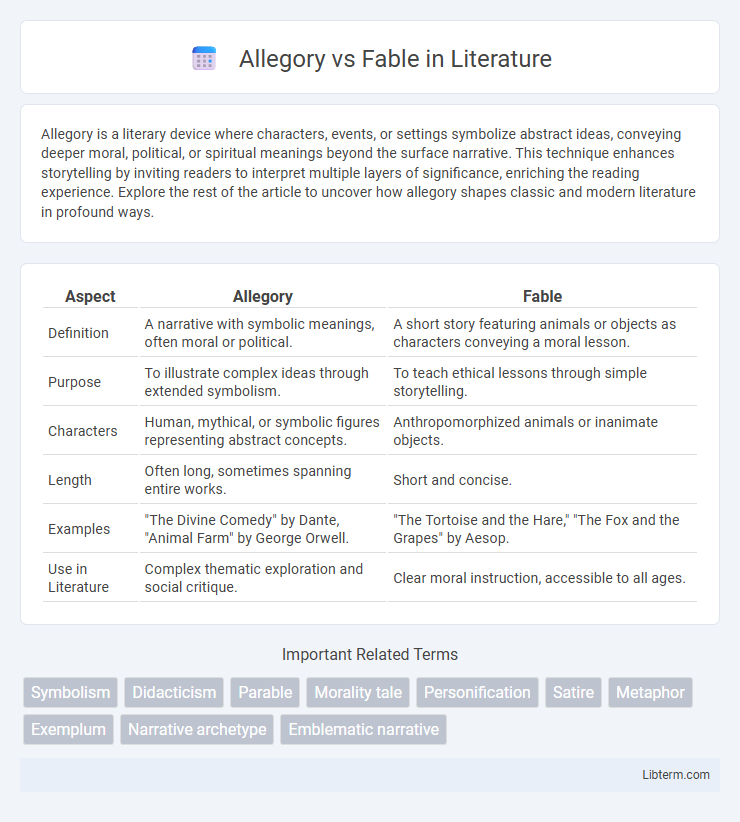Allegory is a literary device where characters, events, or settings symbolize abstract ideas, conveying deeper moral, political, or spiritual meanings beyond the surface narrative. This technique enhances storytelling by inviting readers to interpret multiple layers of significance, enriching the reading experience. Explore the rest of the article to uncover how allegory shapes classic and modern literature in profound ways.
Table of Comparison
| Aspect | Allegory | Fable |
|---|---|---|
| Definition | A narrative with symbolic meanings, often moral or political. | A short story featuring animals or objects as characters conveying a moral lesson. |
| Purpose | To illustrate complex ideas through extended symbolism. | To teach ethical lessons through simple storytelling. |
| Characters | Human, mythical, or symbolic figures representing abstract concepts. | Anthropomorphized animals or inanimate objects. |
| Length | Often long, sometimes spanning entire works. | Short and concise. |
| Examples | "The Divine Comedy" by Dante, "Animal Farm" by George Orwell. | "The Tortoise and the Hare," "The Fox and the Grapes" by Aesop. |
| Use in Literature | Complex thematic exploration and social critique. | Clear moral instruction, accessible to all ages. |
Introduction to Allegory and Fable
Allegory and fable are literary devices used to convey deeper moral or political meanings through storytelling. Allegory employs symbolic characters, actions, or settings to represent abstract concepts or real-world issues, often extending throughout an entire narrative. Fables are brief stories featuring animals or inanimate objects as characters, delivering clear moral lessons through simple, memorable plots.
Defining Allegory: Core Characteristics
Allegory is a narrative device where characters, events, and settings symbolically represent abstract ideas, often conveying moral, social, or political messages. Core characteristics include dual-level storytelling, where the surface plot reflects a deeper, symbolic meaning, and a systematic framework that integrates these symbols coherently throughout the work. Unlike fables, allegories typically employ complex and extended metaphors rather than simple, direct lessons.
Defining Fable: Key Elements
A fable is a concise narrative that uses anthropomorphic animals, plants, or inanimate objects as characters to convey a clear moral lesson. Key elements include simple plot structures, direct cause-and-effect relationships, and explicit ethical teachings often summarized at the story's end. Unlike allegories, which can be complex and multi-layered, fables prioritize straightforward storytelling to impart practical wisdom to readers.
Historical Origins of Allegories and Fables
Allegories originate from ancient Greek and Roman literature, serving as extended metaphors that convey moral, political, or spiritual meanings through symbolic characters and narratives. Fables, traced back to Aesop in the 6th century BCE, are brief tales featuring animals with human traits to impart simple ethical lessons. Both forms have evolved over centuries, influencing storytelling traditions worldwide with their distinctive approaches to teaching values.
Purpose and Function in Literature
Allegories serve to convey complex philosophical or moral ideas through extended symbolic narratives that often operate on multiple levels, providing readers with deeper interpretive layers. Fables deliver straightforward moral lessons through brief, simple stories typically featuring anthropomorphized animals, making ethical guidance easily accessible. Both literary forms function to teach and reflect ethical principles, but allegories engage with abstract concepts while fables emphasize practical wisdom.
Differences in Symbolism and Moral Lessons
Allegories use extended symbolism to represent abstract ideas or principles throughout an entire narrative, allowing for complex and layered interpretations, while fables rely on simple, direct symbolism often embodied by animals to convey clear moral lessons. The moral lessons in allegories are typically nuanced and open to interpretation, reflecting broader philosophical or social themes, whereas fables deliver concise, straightforward morals explicitly stated at the end of the story. This distinction highlights allegory's depth in symbolic meaning versus fable's focused use of symbolism for immediate ethical instruction.
Famous Allegories in Literary History
Famous allegories in literary history often include works like George Orwell's *Animal Farm*, which uses animals to symbolize political ideologies and critique totalitarian regimes, and John Bunyan's *The Pilgrim's Progress*, an extended metaphor for the Christian journey of faith. Allegories differ from fables by conveying complex moral, social, or political messages through symbolic characters and narratives rather than simple tales with explicit morals. These classic allegories have endured due to their deep exploration of abstract concepts embedded in relatable stories, influencing literature and political thought across centuries.
Classic Examples of Fables
Classic examples of fables often feature anthropomorphic animals delivering moral lessons, such as Aesop's "The Tortoise and the Hare," which illustrates the value of perseverance over speed. Unlike allegories, which use extended narratives to symbolize broader concepts or real-world events, fables provide concise stories with clear ethical takeaways. Other notable fables include "The Fox and the Grapes" and "The Boy Who Cried Wolf," each emphasizing practical wisdom through simple, memorable characters.
Allegory and Fable in Modern Storytelling
Allegory in modern storytelling employs symbolic figures and actions to convey complex moral, political, or social meanings beyond the surface narrative. Fables use concise tales featuring anthropomorphic animals or objects to deliver clear, direct moral lessons, often aimed at younger audiences. Both forms harness metaphorical elements but differ in complexity and audience engagement, with allegories typically inviting deeper interpretation and fables emphasizing straightforward didacticism.
Choosing Between Allegory and Fable: Author’s Perspective
Authors choosing between allegory and fable consider the complexity of their message and target audience; allegories use extended narratives with layered meanings suitable for mature readers, while fables deliver concise moral lessons through anthropomorphic characters ideal for children. The decision often depends on the desired depth of interpretation and the effectiveness of symbolism to convey ethical or philosophical ideas. Understanding these distinctions enables writers to craft stories that resonate appropriately with their readers and fulfill the intended educational or reflective purpose.
Allegory Infographic

 libterm.com
libterm.com